Business Structures and Organizational Frameworks: A Report
VerifiedAdded on 2021/02/19
|19
|5507
|36
Report
AI Summary
This report provides a comprehensive analysis of organizational structures, encompassing various types, sizes, and scopes of businesses. It delves into the distinctions between profit and non-profit organizations, exploring legal structures such as sole proprietorships, partnerships, and limited companies. The report examines the significance of company size, including micro, small, medium, and large enterprises, as well as transnational and international corporations. Case studies of Tesco and Greenpeace are used to illustrate these concepts, with a focus on their vision, mission, and objectives. The interconnectedness of organizational departments and their contribution to overall business efficiency are also discussed. This report aims to provide a solid understanding of the complex interplay of factors that shape business organizations, enabling a better understanding of the business environment.

Declaration: I certify that the work submitted for this unit is my own and the research sources
are fully acknowledged.
are fully acknowledged.
Paraphrase This Document
Need a fresh take? Get an instant paraphrase of this document with our AI Paraphraser
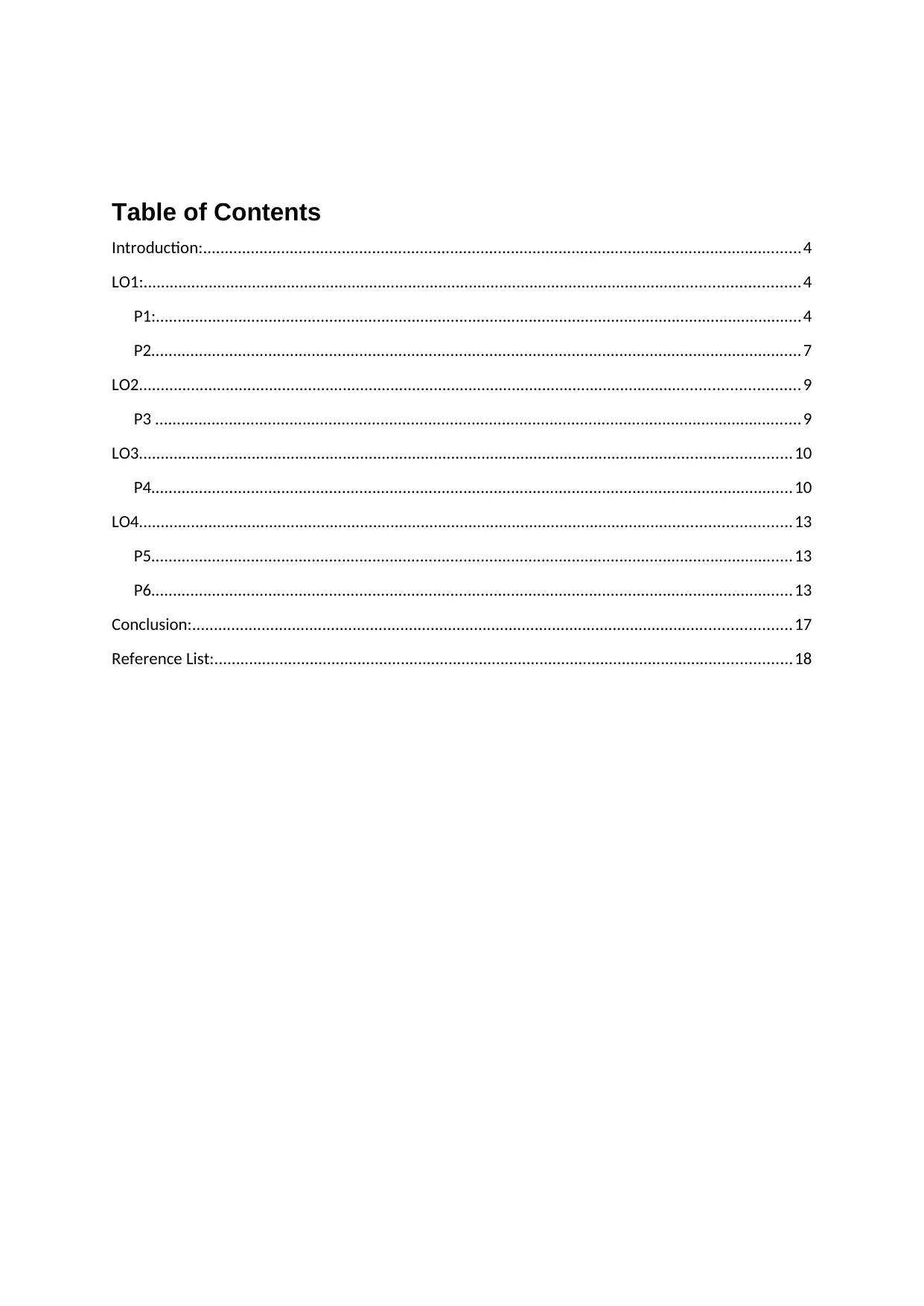
Table of Contents
Introduction:..........................................................................................................................................4
LO1:.......................................................................................................................................................4
P1:.....................................................................................................................................................4
P2......................................................................................................................................................7
LO2........................................................................................................................................................9
P3 .....................................................................................................................................................9
LO3......................................................................................................................................................10
P4....................................................................................................................................................10
LO4......................................................................................................................................................13
P5....................................................................................................................................................13
P6....................................................................................................................................................13
Conclusion:..........................................................................................................................................17
Reference List:.....................................................................................................................................18
Introduction:..........................................................................................................................................4
LO1:.......................................................................................................................................................4
P1:.....................................................................................................................................................4
P2......................................................................................................................................................7
LO2........................................................................................................................................................9
P3 .....................................................................................................................................................9
LO3......................................................................................................................................................10
P4....................................................................................................................................................10
LO4......................................................................................................................................................13
P5....................................................................................................................................................13
P6....................................................................................................................................................13
Conclusion:..........................................................................................................................................17
Reference List:.....................................................................................................................................18

⊘ This is a preview!⊘
Do you want full access?
Subscribe today to unlock all pages.

Trusted by 1+ million students worldwide
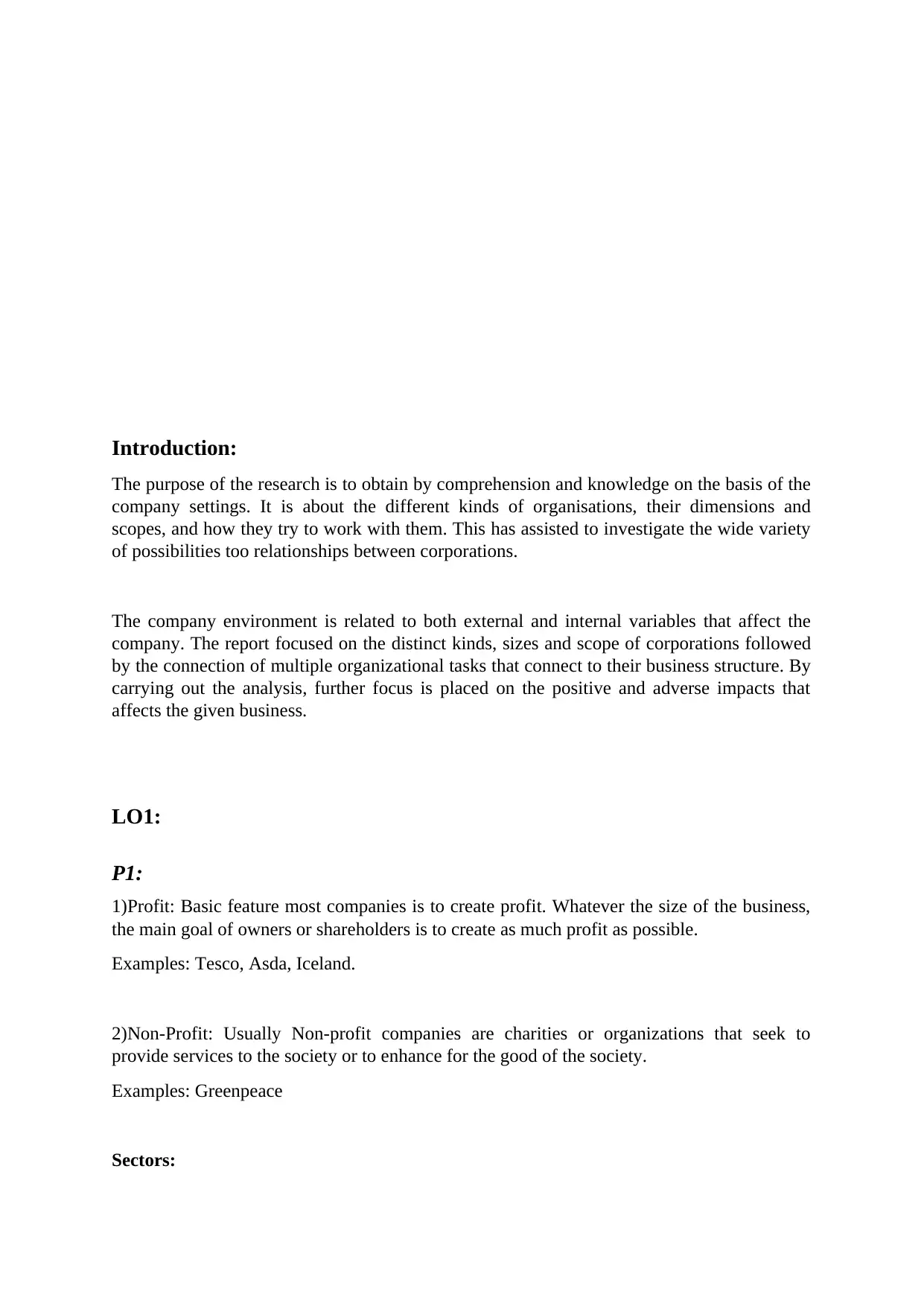
Introduction:
The purpose of the research is to obtain by comprehension and knowledge on the basis of the
company settings. It is about the different kinds of organisations, their dimensions and
scopes, and how they try to work with them. This has assisted to investigate the wide variety
of possibilities too relationships between corporations.
The company environment is related to both external and internal variables that affect the
company. The report focused on the distinct kinds, sizes and scope of corporations followed
by the connection of multiple organizational tasks that connect to their business structure. By
carrying out the analysis, further focus is placed on the positive and adverse impacts that
affects the given business.
LO1:
P1:
1)Profit: Basic feature most companies is to create profit. Whatever the size of the business,
the main goal of owners or shareholders is to create as much profit as possible.
Examples: Tesco, Asda, Iceland.
2)Non-Profit: Usually Non-profit companies are charities or organizations that seek to
provide services to the society or to enhance for the good of the society.
Examples: Greenpeace
Sectors:
The purpose of the research is to obtain by comprehension and knowledge on the basis of the
company settings. It is about the different kinds of organisations, their dimensions and
scopes, and how they try to work with them. This has assisted to investigate the wide variety
of possibilities too relationships between corporations.
The company environment is related to both external and internal variables that affect the
company. The report focused on the distinct kinds, sizes and scope of corporations followed
by the connection of multiple organizational tasks that connect to their business structure. By
carrying out the analysis, further focus is placed on the positive and adverse impacts that
affects the given business.
LO1:
P1:
1)Profit: Basic feature most companies is to create profit. Whatever the size of the business,
the main goal of owners or shareholders is to create as much profit as possible.
Examples: Tesco, Asda, Iceland.
2)Non-Profit: Usually Non-profit companies are charities or organizations that seek to
provide services to the society or to enhance for the good of the society.
Examples: Greenpeace
Sectors:
Paraphrase This Document
Need a fresh take? Get an instant paraphrase of this document with our AI Paraphraser
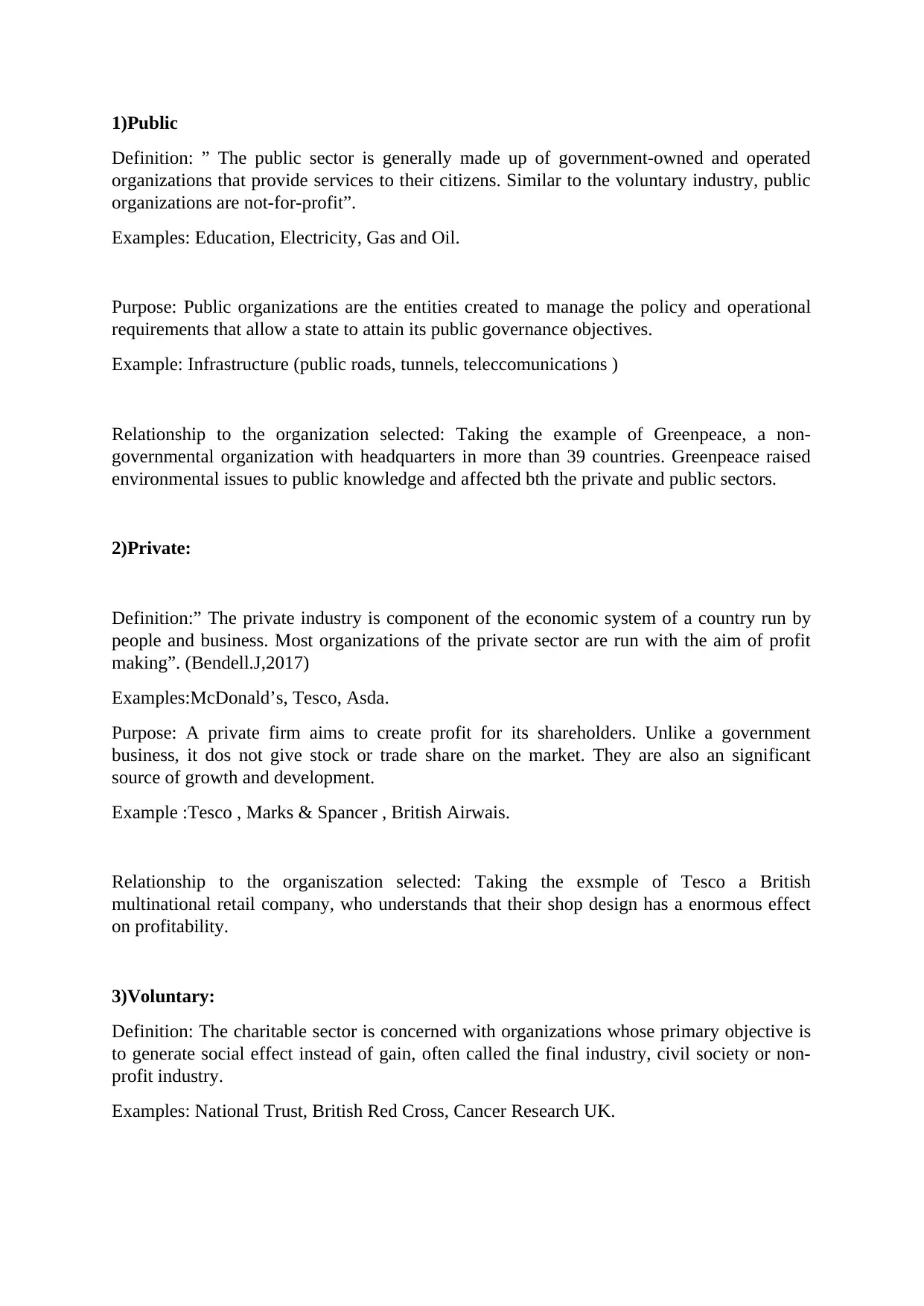
1)Public
Definition: ” The public sector is generally made up of government-owned and operated
organizations that provide services to their citizens. Similar to the voluntary industry, public
organizations are not-for-profit”.
Examples: Education, Electricity, Gas and Oil.
Purpose: Public organizations are the entities created to manage the policy and operational
requirements that allow a state to attain its public governance objectives.
Example: Infrastructure (public roads, tunnels, teleccomunications )
Relationship to the organization selected: Taking the example of Greenpeace, a non-
governmental organization with headquarters in more than 39 countries. Greenpeace raised
environmental issues to public knowledge and affected bth the private and public sectors.
2)Private:
Definition:” The private industry is component of the economic system of a country run by
people and business. Most organizations of the private sector are run with the aim of profit
making”. (Bendell.J,2017)
Examples:McDonald’s, Tesco, Asda.
Purpose: A private firm aims to create profit for its shareholders. Unlike a government
business, it dos not give stock or trade share on the market. They are also an significant
source of growth and development.
Example :Tesco , Marks & Spancer , British Airwais.
Relationship to the organiszation selected: Taking the exsmple of Tesco a British
multinational retail company, who understands that their shop design has a enormous effect
on profitability.
3)Voluntary:
Definition: The charitable sector is concerned with organizations whose primary objective is
to generate social effect instead of gain, often called the final industry, civil society or non-
profit industry.
Examples: National Trust, British Red Cross, Cancer Research UK.
Definition: ” The public sector is generally made up of government-owned and operated
organizations that provide services to their citizens. Similar to the voluntary industry, public
organizations are not-for-profit”.
Examples: Education, Electricity, Gas and Oil.
Purpose: Public organizations are the entities created to manage the policy and operational
requirements that allow a state to attain its public governance objectives.
Example: Infrastructure (public roads, tunnels, teleccomunications )
Relationship to the organization selected: Taking the example of Greenpeace, a non-
governmental organization with headquarters in more than 39 countries. Greenpeace raised
environmental issues to public knowledge and affected bth the private and public sectors.
2)Private:
Definition:” The private industry is component of the economic system of a country run by
people and business. Most organizations of the private sector are run with the aim of profit
making”. (Bendell.J,2017)
Examples:McDonald’s, Tesco, Asda.
Purpose: A private firm aims to create profit for its shareholders. Unlike a government
business, it dos not give stock or trade share on the market. They are also an significant
source of growth and development.
Example :Tesco , Marks & Spancer , British Airwais.
Relationship to the organiszation selected: Taking the exsmple of Tesco a British
multinational retail company, who understands that their shop design has a enormous effect
on profitability.
3)Voluntary:
Definition: The charitable sector is concerned with organizations whose primary objective is
to generate social effect instead of gain, often called the final industry, civil society or non-
profit industry.
Examples: National Trust, British Red Cross, Cancer Research UK.
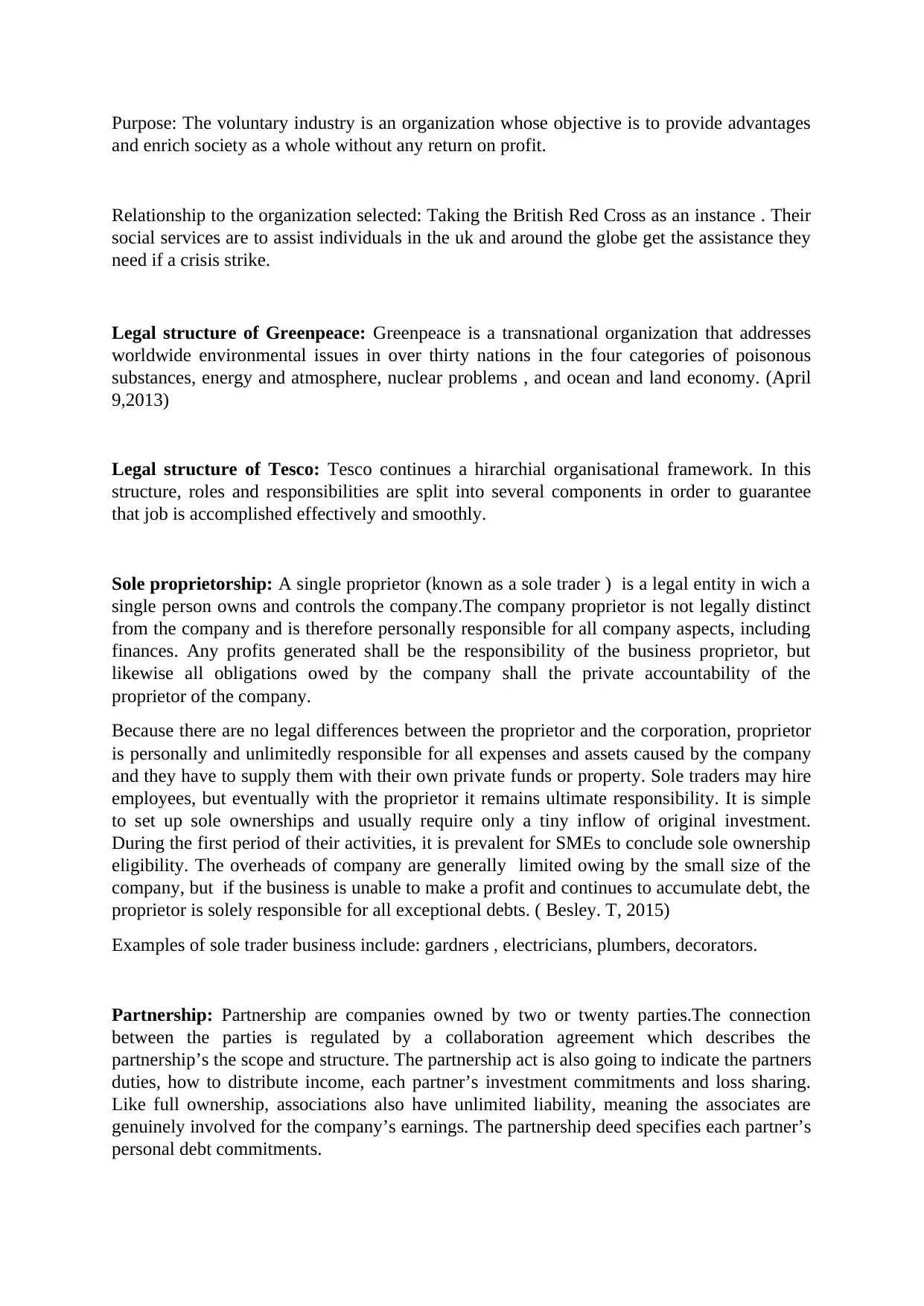
Purpose: The voluntary industry is an organization whose objective is to provide advantages
and enrich society as a whole without any return on profit.
Relationship to the organization selected: Taking the British Red Cross as an instance . Their
social services are to assist individuals in the uk and around the globe get the assistance they
need if a crisis strike.
Legal structure of Greenpeace: Greenpeace is a transnational organization that addresses
worldwide environmental issues in over thirty nations in the four categories of poisonous
substances, energy and atmosphere, nuclear problems , and ocean and land economy. (April
9,2013)
Legal structure of Tesco: Tesco continues a hirarchial organisational framework. In this
structure, roles and responsibilities are split into several components in order to guarantee
that job is accomplished effectively and smoothly.
Sole proprietorship: A single proprietor (known as a sole trader ) is a legal entity in wich a
single person owns and controls the company.The company proprietor is not legally distinct
from the company and is therefore personally responsible for all company aspects, including
finances. Any profits generated shall be the responsibility of the business proprietor, but
likewise all obligations owed by the company shall the private accountability of the
proprietor of the company.
Because there are no legal differences between the proprietor and the corporation, proprietor
is personally and unlimitedly responsible for all expenses and assets caused by the company
and they have to supply them with their own private funds or property. Sole traders may hire
employees, but eventually with the proprietor it remains ultimate responsibility. It is simple
to set up sole ownerships and usually require only a tiny inflow of original investment.
During the first period of their activities, it is prevalent for SMEs to conclude sole ownership
eligibility. The overheads of company are generally limited owing by the small size of the
company, but if the business is unable to make a profit and continues to accumulate debt, the
proprietor is solely responsible for all exceptional debts. ( Besley. T, 2015)
Examples of sole trader business include: gardners , electricians, plumbers, decorators.
Partnership: Partnership are companies owned by two or twenty parties.The connection
between the parties is regulated by a collaboration agreement which describes the
partnership’s the scope and structure. The partnership act is also going to indicate the partners
duties, how to distribute income, each partner’s investment commitments and loss sharing.
Like full ownership, associations also have unlimited liability, meaning the associates are
genuinely involved for the company’s earnings. The partnership deed specifies each partner’s
personal debt commitments.
and enrich society as a whole without any return on profit.
Relationship to the organization selected: Taking the British Red Cross as an instance . Their
social services are to assist individuals in the uk and around the globe get the assistance they
need if a crisis strike.
Legal structure of Greenpeace: Greenpeace is a transnational organization that addresses
worldwide environmental issues in over thirty nations in the four categories of poisonous
substances, energy and atmosphere, nuclear problems , and ocean and land economy. (April
9,2013)
Legal structure of Tesco: Tesco continues a hirarchial organisational framework. In this
structure, roles and responsibilities are split into several components in order to guarantee
that job is accomplished effectively and smoothly.
Sole proprietorship: A single proprietor (known as a sole trader ) is a legal entity in wich a
single person owns and controls the company.The company proprietor is not legally distinct
from the company and is therefore personally responsible for all company aspects, including
finances. Any profits generated shall be the responsibility of the business proprietor, but
likewise all obligations owed by the company shall the private accountability of the
proprietor of the company.
Because there are no legal differences between the proprietor and the corporation, proprietor
is personally and unlimitedly responsible for all expenses and assets caused by the company
and they have to supply them with their own private funds or property. Sole traders may hire
employees, but eventually with the proprietor it remains ultimate responsibility. It is simple
to set up sole ownerships and usually require only a tiny inflow of original investment.
During the first period of their activities, it is prevalent for SMEs to conclude sole ownership
eligibility. The overheads of company are generally limited owing by the small size of the
company, but if the business is unable to make a profit and continues to accumulate debt, the
proprietor is solely responsible for all exceptional debts. ( Besley. T, 2015)
Examples of sole trader business include: gardners , electricians, plumbers, decorators.
Partnership: Partnership are companies owned by two or twenty parties.The connection
between the parties is regulated by a collaboration agreement which describes the
partnership’s the scope and structure. The partnership act is also going to indicate the partners
duties, how to distribute income, each partner’s investment commitments and loss sharing.
Like full ownership, associations also have unlimited liability, meaning the associates are
genuinely involved for the company’s earnings. The partnership deed specifies each partner’s
personal debt commitments.
⊘ This is a preview!⊘
Do you want full access?
Subscribe today to unlock all pages.

Trusted by 1+ million students worldwide
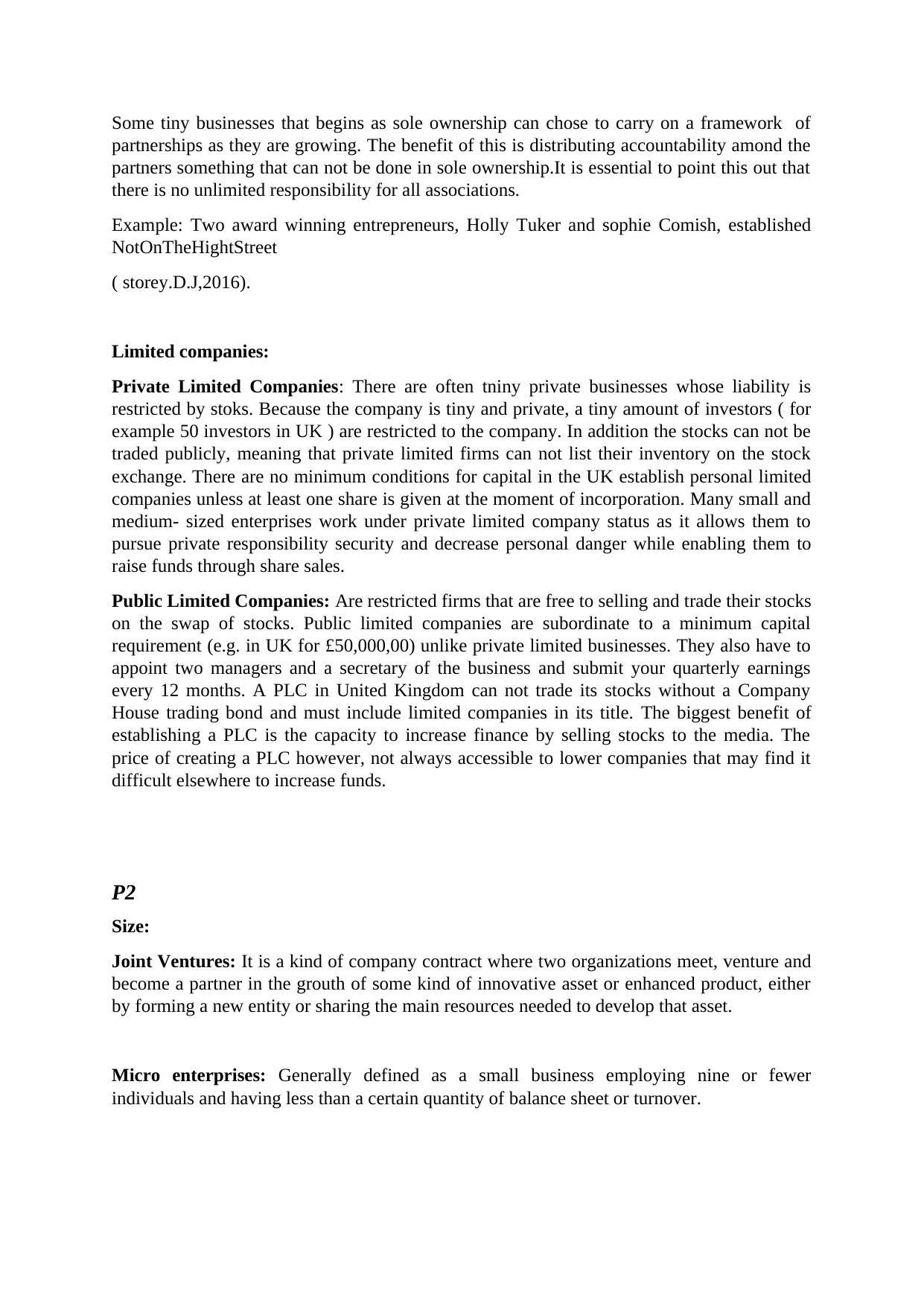
Some tiny businesses that begins as sole ownership can chose to carry on a framework of
partnerships as they are growing. The benefit of this is distributing accountability amond the
partners something that can not be done in sole ownership.It is essential to point this out that
there is no unlimited responsibility for all associations.
Example: Two award winning entrepreneurs, Holly Tuker and sophie Comish, established
NotOnTheHightStreet
( storey.D.J,2016).
Limited companies:
Private Limited Companies: There are often tniny private businesses whose liability is
restricted by stoks. Because the company is tiny and private, a tiny amount of investors ( for
example 50 investors in UK ) are restricted to the company. In addition the stocks can not be
traded publicly, meaning that private limited firms can not list their inventory on the stock
exchange. There are no minimum conditions for capital in the UK establish personal limited
companies unless at least one share is given at the moment of incorporation. Many small and
medium- sized enterprises work under private limited company status as it allows them to
pursue private responsibility security and decrease personal danger while enabling them to
raise funds through share sales.
Public Limited Companies: Are restricted firms that are free to selling and trade their stocks
on the swap of stocks. Public limited companies are subordinate to a minimum capital
requirement (e.g. in UK for £50,000,00) unlike private limited businesses. They also have to
appoint two managers and a secretary of the business and submit your quarterly earnings
every 12 months. A PLC in United Kingdom can not trade its stocks without a Company
House trading bond and must include limited companies in its title. The biggest benefit of
establishing a PLC is the capacity to increase finance by selling stocks to the media. The
price of creating a PLC however, not always accessible to lower companies that may find it
difficult elsewhere to increase funds.
P2
Size:
Joint Ventures: It is a kind of company contract where two organizations meet, venture and
become a partner in the grouth of some kind of innovative asset or enhanced product, either
by forming a new entity or sharing the main resources needed to develop that asset.
Micro enterprises: Generally defined as a small business employing nine or fewer
individuals and having less than a certain quantity of balance sheet or turnover.
partnerships as they are growing. The benefit of this is distributing accountability amond the
partners something that can not be done in sole ownership.It is essential to point this out that
there is no unlimited responsibility for all associations.
Example: Two award winning entrepreneurs, Holly Tuker and sophie Comish, established
NotOnTheHightStreet
( storey.D.J,2016).
Limited companies:
Private Limited Companies: There are often tniny private businesses whose liability is
restricted by stoks. Because the company is tiny and private, a tiny amount of investors ( for
example 50 investors in UK ) are restricted to the company. In addition the stocks can not be
traded publicly, meaning that private limited firms can not list their inventory on the stock
exchange. There are no minimum conditions for capital in the UK establish personal limited
companies unless at least one share is given at the moment of incorporation. Many small and
medium- sized enterprises work under private limited company status as it allows them to
pursue private responsibility security and decrease personal danger while enabling them to
raise funds through share sales.
Public Limited Companies: Are restricted firms that are free to selling and trade their stocks
on the swap of stocks. Public limited companies are subordinate to a minimum capital
requirement (e.g. in UK for £50,000,00) unlike private limited businesses. They also have to
appoint two managers and a secretary of the business and submit your quarterly earnings
every 12 months. A PLC in United Kingdom can not trade its stocks without a Company
House trading bond and must include limited companies in its title. The biggest benefit of
establishing a PLC is the capacity to increase finance by selling stocks to the media. The
price of creating a PLC however, not always accessible to lower companies that may find it
difficult elsewhere to increase funds.
P2
Size:
Joint Ventures: It is a kind of company contract where two organizations meet, venture and
become a partner in the grouth of some kind of innovative asset or enhanced product, either
by forming a new entity or sharing the main resources needed to develop that asset.
Micro enterprises: Generally defined as a small business employing nine or fewer
individuals and having less than a certain quantity of balance sheet or turnover.
Paraphrase This Document
Need a fresh take? Get an instant paraphrase of this document with our AI Paraphraser
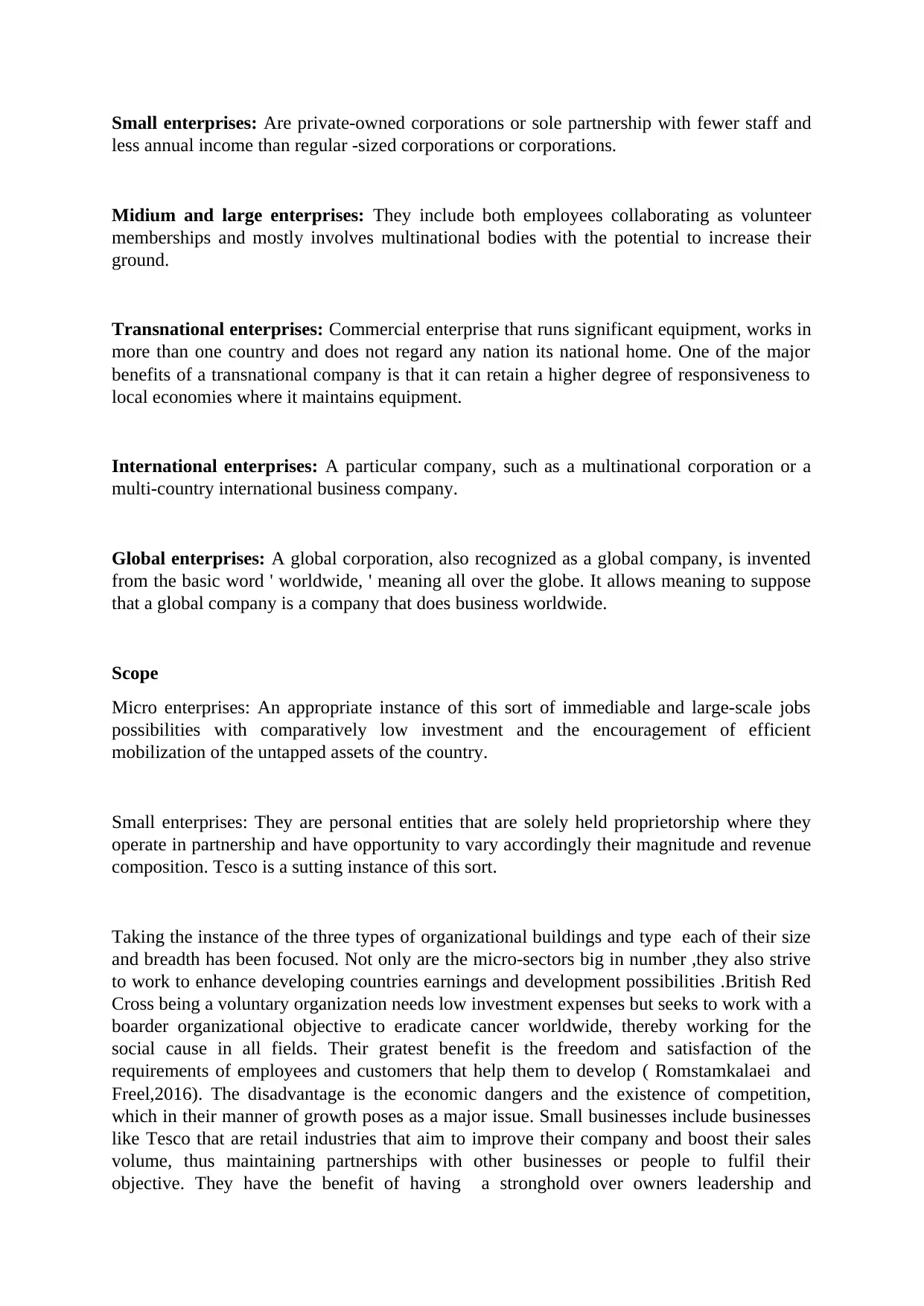
Small enterprises: Are private-owned corporations or sole partnership with fewer staff and
less annual income than regular -sized corporations or corporations.
Midium and large enterprises: They include both employees collaborating as volunteer
memberships and mostly involves multinational bodies with the potential to increase their
ground.
Transnational enterprises: Commercial enterprise that runs significant equipment, works in
more than one country and does not regard any nation its national home. One of the major
benefits of a transnational company is that it can retain a higher degree of responsiveness to
local economies where it maintains equipment.
International enterprises: A particular company, such as a multinational corporation or a
multi-country international business company.
Global enterprises: A global corporation, also recognized as a global company, is invented
from the basic word ' worldwide, ' meaning all over the globe. It allows meaning to suppose
that a global company is a company that does business worldwide.
Scope
Micro enterprises: An appropriate instance of this sort of immediable and large-scale jobs
possibilities with comparatively low investment and the encouragement of efficient
mobilization of the untapped assets of the country.
Small enterprises: They are personal entities that are solely held proprietorship where they
operate in partnership and have opportunity to vary accordingly their magnitude and revenue
composition. Tesco is a sutting instance of this sort.
Taking the instance of the three types of organizational buildings and type each of their size
and breadth has been focused. Not only are the micro-sectors big in number ,they also strive
to work to enhance developing countries earnings and development possibilities .British Red
Cross being a voluntary organization needs low investment expenses but seeks to work with a
boarder organizational objective to eradicate cancer worldwide, thereby working for the
social cause in all fields. Their gratest benefit is the freedom and satisfaction of the
requirements of employees and customers that help them to develop ( Romstamkalaei and
Freel,2016). The disadvantage is the economic dangers and the existence of competition,
which in their manner of growth poses as a major issue. Small businesses include businesses
like Tesco that are retail industries that aim to improve their company and boost their sales
volume, thus maintaining partnerships with other businesses or people to fulfil their
objective. They have the benefit of having a stronghold over owners leadership and
less annual income than regular -sized corporations or corporations.
Midium and large enterprises: They include both employees collaborating as volunteer
memberships and mostly involves multinational bodies with the potential to increase their
ground.
Transnational enterprises: Commercial enterprise that runs significant equipment, works in
more than one country and does not regard any nation its national home. One of the major
benefits of a transnational company is that it can retain a higher degree of responsiveness to
local economies where it maintains equipment.
International enterprises: A particular company, such as a multinational corporation or a
multi-country international business company.
Global enterprises: A global corporation, also recognized as a global company, is invented
from the basic word ' worldwide, ' meaning all over the globe. It allows meaning to suppose
that a global company is a company that does business worldwide.
Scope
Micro enterprises: An appropriate instance of this sort of immediable and large-scale jobs
possibilities with comparatively low investment and the encouragement of efficient
mobilization of the untapped assets of the country.
Small enterprises: They are personal entities that are solely held proprietorship where they
operate in partnership and have opportunity to vary accordingly their magnitude and revenue
composition. Tesco is a sutting instance of this sort.
Taking the instance of the three types of organizational buildings and type each of their size
and breadth has been focused. Not only are the micro-sectors big in number ,they also strive
to work to enhance developing countries earnings and development possibilities .British Red
Cross being a voluntary organization needs low investment expenses but seeks to work with a
boarder organizational objective to eradicate cancer worldwide, thereby working for the
social cause in all fields. Their gratest benefit is the freedom and satisfaction of the
requirements of employees and customers that help them to develop ( Romstamkalaei and
Freel,2016). The disadvantage is the economic dangers and the existence of competition,
which in their manner of growth poses as a major issue. Small businesses include businesses
like Tesco that are retail industries that aim to improve their company and boost their sales
volume, thus maintaining partnerships with other businesses or people to fulfil their
objective. They have the benefit of having a stronghold over owners leadership and
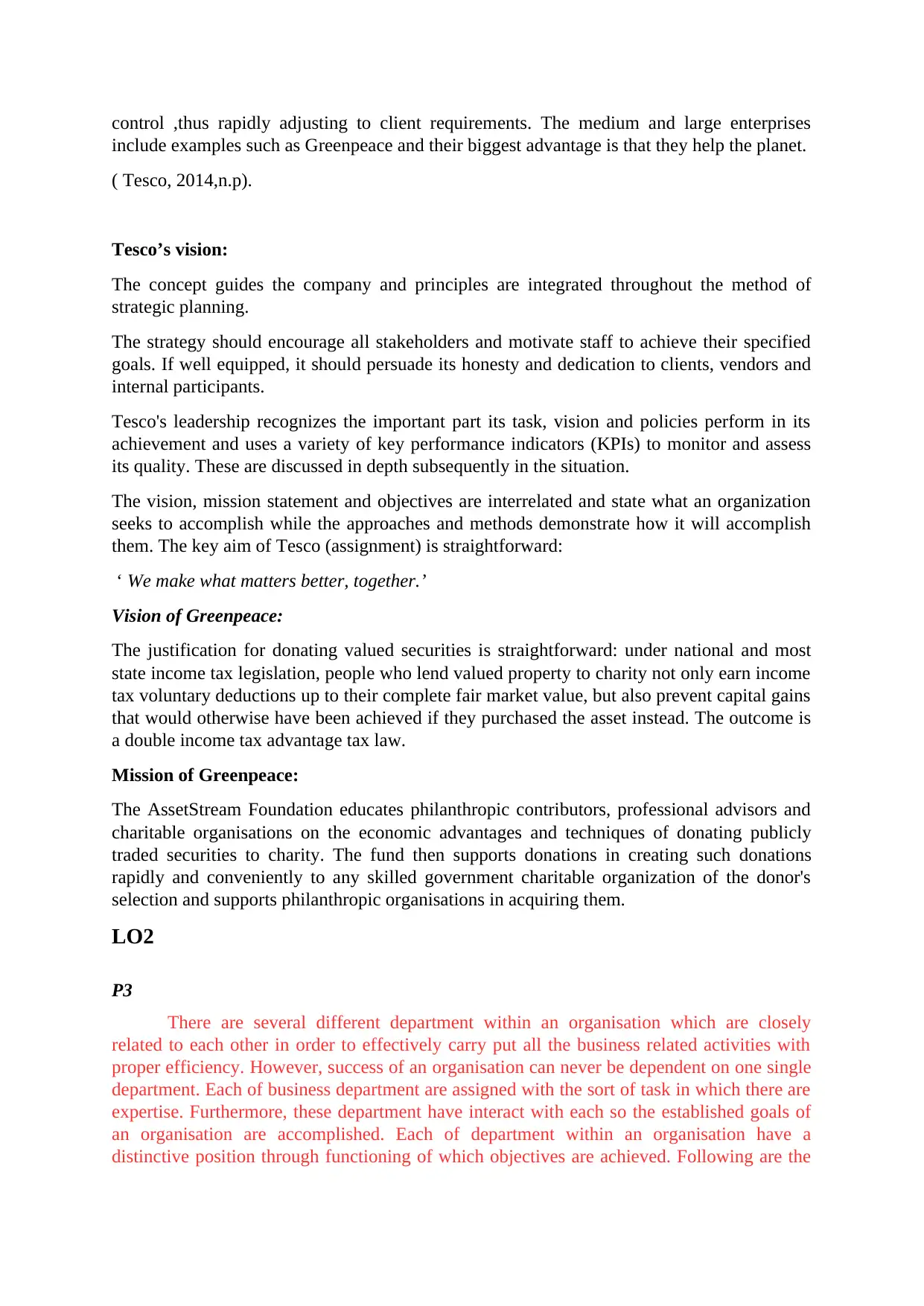
control ,thus rapidly adjusting to client requirements. The medium and large enterprises
include examples such as Greenpeace and their biggest advantage is that they help the planet.
( Tesco, 2014,n.p).
Tesco’s vision:
The concept guides the company and principles are integrated throughout the method of
strategic planning.
The strategy should encourage all stakeholders and motivate staff to achieve their specified
goals. If well equipped, it should persuade its honesty and dedication to clients, vendors and
internal participants.
Tesco's leadership recognizes the important part its task, vision and policies perform in its
achievement and uses a variety of key performance indicators (KPIs) to monitor and assess
its quality. These are discussed in depth subsequently in the situation.
The vision, mission statement and objectives are interrelated and state what an organization
seeks to accomplish while the approaches and methods demonstrate how it will accomplish
them. The key aim of Tesco (assignment) is straightforward:
‘ We make what matters better, together.’
Vision of Greenpeace:
The justification for donating valued securities is straightforward: under national and most
state income tax legislation, people who lend valued property to charity not only earn income
tax voluntary deductions up to their complete fair market value, but also prevent capital gains
that would otherwise have been achieved if they purchased the asset instead. The outcome is
a double income tax advantage tax law.
Mission of Greenpeace:
The AssetStream Foundation educates philanthropic contributors, professional advisors and
charitable organisations on the economic advantages and techniques of donating publicly
traded securities to charity. The fund then supports donations in creating such donations
rapidly and conveniently to any skilled government charitable organization of the donor's
selection and supports philanthropic organisations in acquiring them.
LO2
P3
There are several different department within an organisation which are closely
related to each other in order to effectively carry put all the business related activities with
proper efficiency. However, success of an organisation can never be dependent on one single
department. Each of business department are assigned with the sort of task in which there are
expertise. Furthermore, these department have interact with each so the established goals of
an organisation are accomplished. Each of department within an organisation have a
distinctive position through functioning of which objectives are achieved. Following are the
include examples such as Greenpeace and their biggest advantage is that they help the planet.
( Tesco, 2014,n.p).
Tesco’s vision:
The concept guides the company and principles are integrated throughout the method of
strategic planning.
The strategy should encourage all stakeholders and motivate staff to achieve their specified
goals. If well equipped, it should persuade its honesty and dedication to clients, vendors and
internal participants.
Tesco's leadership recognizes the important part its task, vision and policies perform in its
achievement and uses a variety of key performance indicators (KPIs) to monitor and assess
its quality. These are discussed in depth subsequently in the situation.
The vision, mission statement and objectives are interrelated and state what an organization
seeks to accomplish while the approaches and methods demonstrate how it will accomplish
them. The key aim of Tesco (assignment) is straightforward:
‘ We make what matters better, together.’
Vision of Greenpeace:
The justification for donating valued securities is straightforward: under national and most
state income tax legislation, people who lend valued property to charity not only earn income
tax voluntary deductions up to their complete fair market value, but also prevent capital gains
that would otherwise have been achieved if they purchased the asset instead. The outcome is
a double income tax advantage tax law.
Mission of Greenpeace:
The AssetStream Foundation educates philanthropic contributors, professional advisors and
charitable organisations on the economic advantages and techniques of donating publicly
traded securities to charity. The fund then supports donations in creating such donations
rapidly and conveniently to any skilled government charitable organization of the donor's
selection and supports philanthropic organisations in acquiring them.
LO2
P3
There are several different department within an organisation which are closely
related to each other in order to effectively carry put all the business related activities with
proper efficiency. However, success of an organisation can never be dependent on one single
department. Each of business department are assigned with the sort of task in which there are
expertise. Furthermore, these department have interact with each so the established goals of
an organisation are accomplished. Each of department within an organisation have a
distinctive position through functioning of which objectives are achieved. Following are the
⊘ This is a preview!⊘
Do you want full access?
Subscribe today to unlock all pages.

Trusted by 1+ million students worldwide
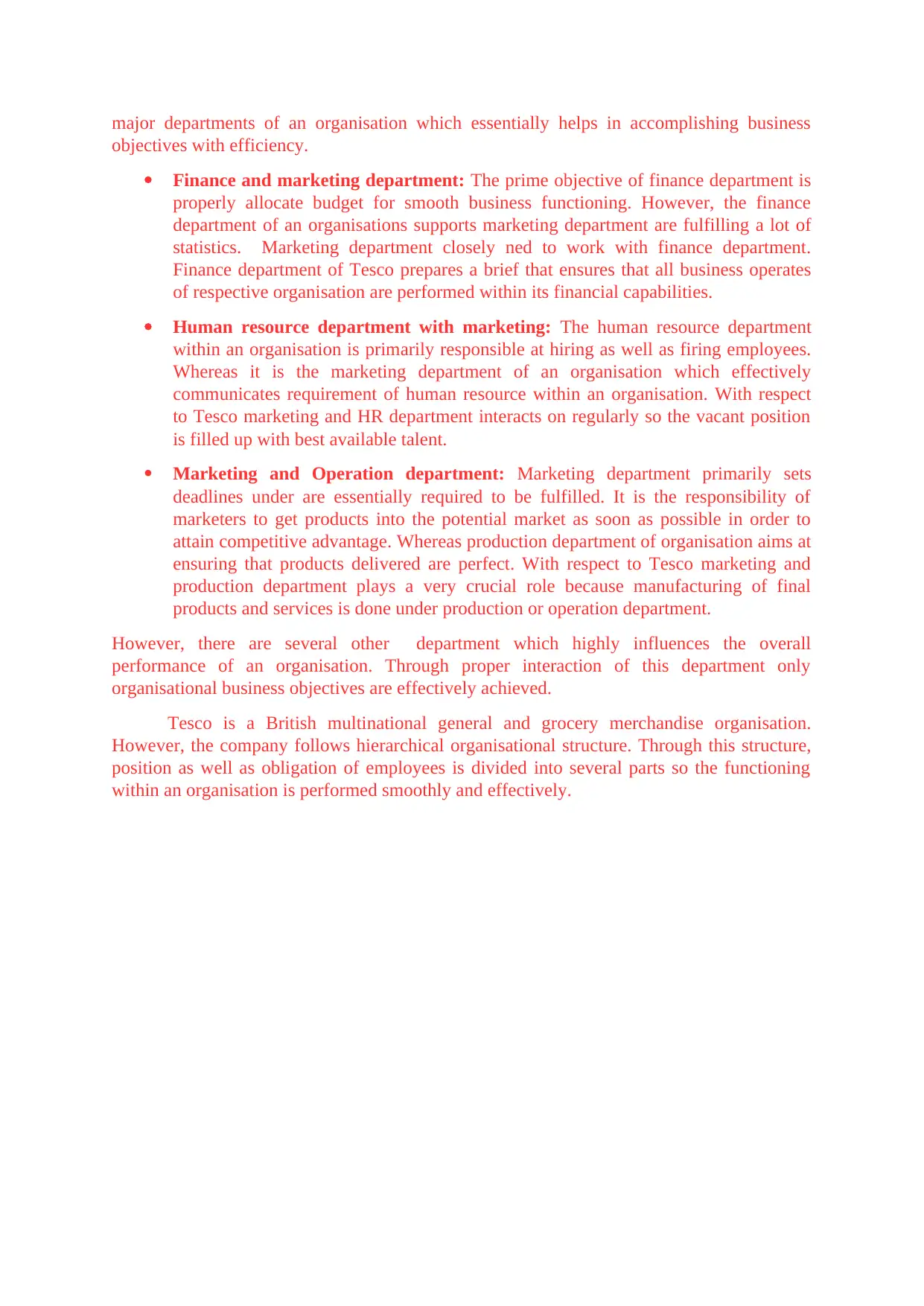
major departments of an organisation which essentially helps in accomplishing business
objectives with efficiency.
Finance and marketing department: The prime objective of finance department is
properly allocate budget for smooth business functioning. However, the finance
department of an organisations supports marketing department are fulfilling a lot of
statistics. Marketing department closely ned to work with finance department.
Finance department of Tesco prepares a brief that ensures that all business operates
of respective organisation are performed within its financial capabilities.
Human resource department with marketing: The human resource department
within an organisation is primarily responsible at hiring as well as firing employees.
Whereas it is the marketing department of an organisation which effectively
communicates requirement of human resource within an organisation. With respect
to Tesco marketing and HR department interacts on regularly so the vacant position
is filled up with best available talent.
Marketing and Operation department: Marketing department primarily sets
deadlines under are essentially required to be fulfilled. It is the responsibility of
marketers to get products into the potential market as soon as possible in order to
attain competitive advantage. Whereas production department of organisation aims at
ensuring that products delivered are perfect. With respect to Tesco marketing and
production department plays a very crucial role because manufacturing of final
products and services is done under production or operation department.
However, there are several other department which highly influences the overall
performance of an organisation. Through proper interaction of this department only
organisational business objectives are effectively achieved.
Tesco is a British multinational general and grocery merchandise organisation.
However, the company follows hierarchical organisational structure. Through this structure,
position as well as obligation of employees is divided into several parts so the functioning
within an organisation is performed smoothly and effectively.
objectives with efficiency.
Finance and marketing department: The prime objective of finance department is
properly allocate budget for smooth business functioning. However, the finance
department of an organisations supports marketing department are fulfilling a lot of
statistics. Marketing department closely ned to work with finance department.
Finance department of Tesco prepares a brief that ensures that all business operates
of respective organisation are performed within its financial capabilities.
Human resource department with marketing: The human resource department
within an organisation is primarily responsible at hiring as well as firing employees.
Whereas it is the marketing department of an organisation which effectively
communicates requirement of human resource within an organisation. With respect
to Tesco marketing and HR department interacts on regularly so the vacant position
is filled up with best available talent.
Marketing and Operation department: Marketing department primarily sets
deadlines under are essentially required to be fulfilled. It is the responsibility of
marketers to get products into the potential market as soon as possible in order to
attain competitive advantage. Whereas production department of organisation aims at
ensuring that products delivered are perfect. With respect to Tesco marketing and
production department plays a very crucial role because manufacturing of final
products and services is done under production or operation department.
However, there are several other department which highly influences the overall
performance of an organisation. Through proper interaction of this department only
organisational business objectives are effectively achieved.
Tesco is a British multinational general and grocery merchandise organisation.
However, the company follows hierarchical organisational structure. Through this structure,
position as well as obligation of employees is divided into several parts so the functioning
within an organisation is performed smoothly and effectively.
Paraphrase This Document
Need a fresh take? Get an instant paraphrase of this document with our AI Paraphraser
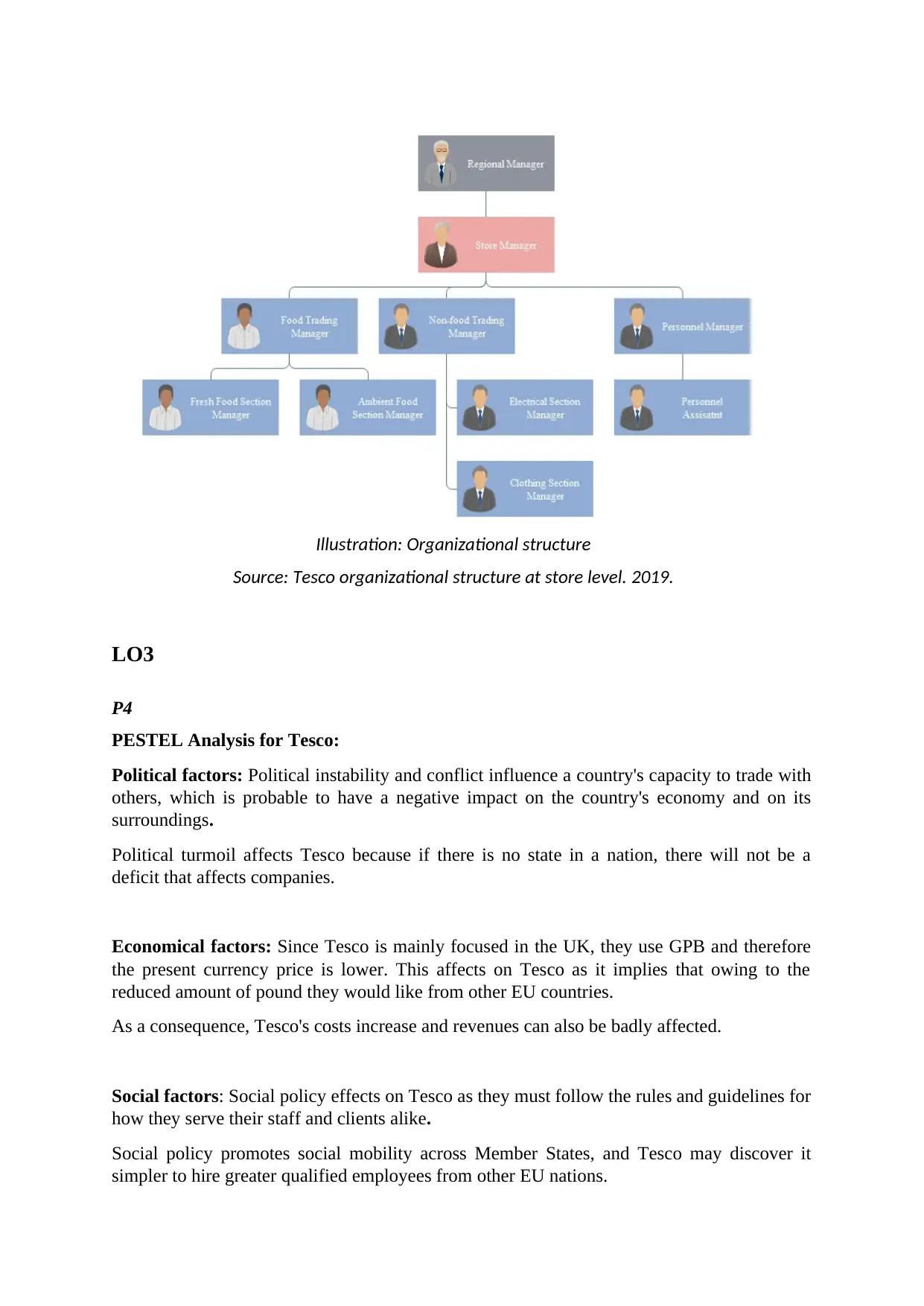
Illustration: Organizational structure
Source: Tesco organizational structure at store level. 2019.
LO3
P4
PESTEL Analysis for Tesco:
Political factors: Political instability and conflict influence a country's capacity to trade with
others, which is probable to have a negative impact on the country's economy and on its
surroundings.
Political turmoil affects Tesco because if there is no state in a nation, there will not be a
deficit that affects companies.
Economical factors: Since Tesco is mainly focused in the UK, they use GPB and therefore
the present currency price is lower. This affects on Tesco as it implies that owing to the
reduced amount of pound they would like from other EU countries.
As a consequence, Tesco's costs increase and revenues can also be badly affected.
Social factors: Social policy effects on Tesco as they must follow the rules and guidelines for
how they serve their staff and clients alike.
Social policy promotes social mobility across Member States, and Tesco may discover it
simpler to hire greater qualified employees from other EU nations.
Source: Tesco organizational structure at store level. 2019.
LO3
P4
PESTEL Analysis for Tesco:
Political factors: Political instability and conflict influence a country's capacity to trade with
others, which is probable to have a negative impact on the country's economy and on its
surroundings.
Political turmoil affects Tesco because if there is no state in a nation, there will not be a
deficit that affects companies.
Economical factors: Since Tesco is mainly focused in the UK, they use GPB and therefore
the present currency price is lower. This affects on Tesco as it implies that owing to the
reduced amount of pound they would like from other EU countries.
As a consequence, Tesco's costs increase and revenues can also be badly affected.
Social factors: Social policy effects on Tesco as they must follow the rules and guidelines for
how they serve their staff and clients alike.
Social policy promotes social mobility across Member States, and Tesco may discover it
simpler to hire greater qualified employees from other EU nations.
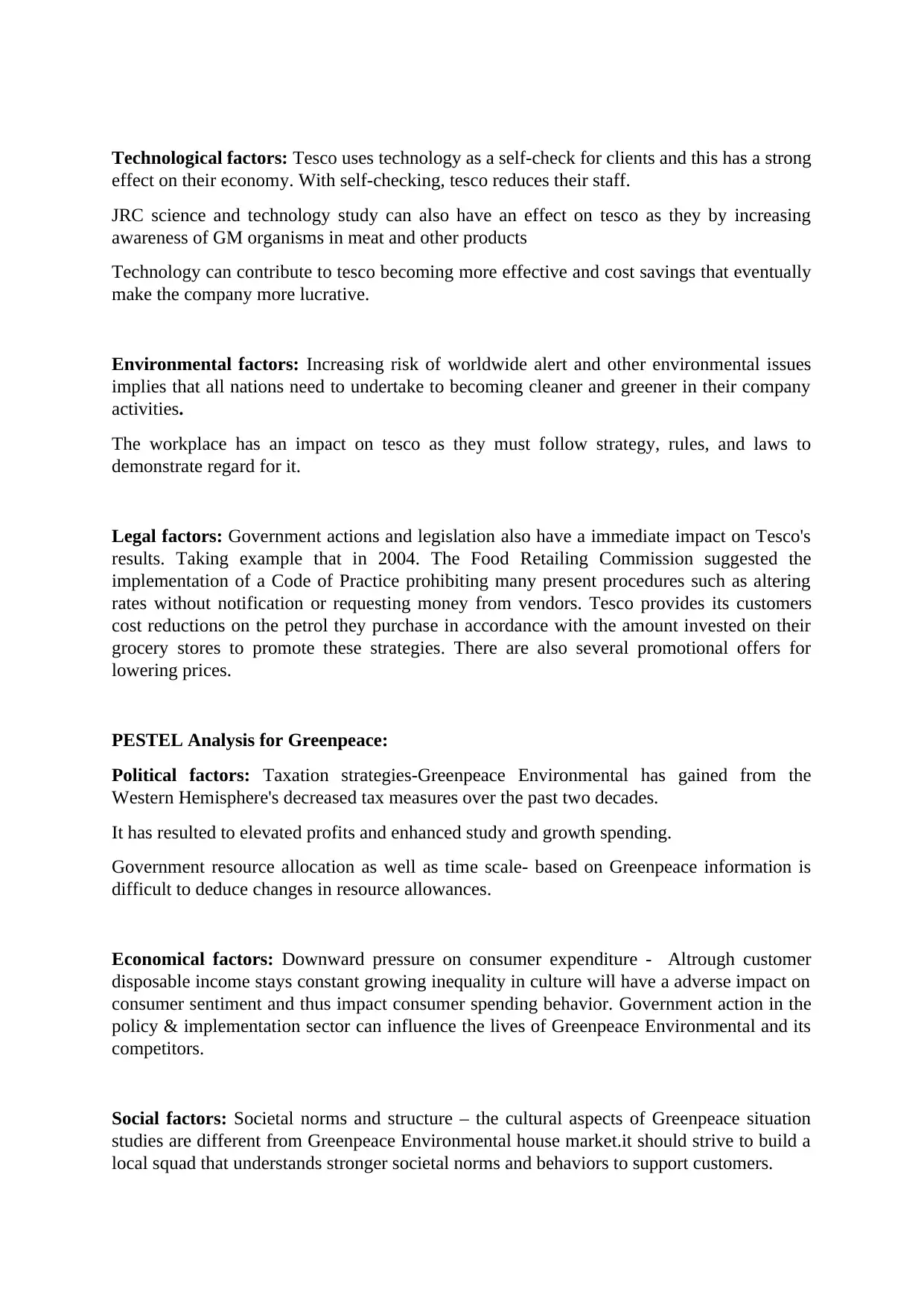
Technological factors: Tesco uses technology as a self-check for clients and this has a strong
effect on their economy. With self-checking, tesco reduces their staff.
JRC science and technology study can also have an effect on tesco as they by increasing
awareness of GM organisms in meat and other products
Technology can contribute to tesco becoming more effective and cost savings that eventually
make the company more lucrative.
Environmental factors: Increasing risk of worldwide alert and other environmental issues
implies that all nations need to undertake to becoming cleaner and greener in their company
activities.
The workplace has an impact on tesco as they must follow strategy, rules, and laws to
demonstrate regard for it.
Legal factors: Government actions and legislation also have a immediate impact on Tesco's
results. Taking example that in 2004. The Food Retailing Commission suggested the
implementation of a Code of Practice prohibiting many present procedures such as altering
rates without notification or requesting money from vendors. Tesco provides its customers
cost reductions on the petrol they purchase in accordance with the amount invested on their
grocery stores to promote these strategies. There are also several promotional offers for
lowering prices.
PESTEL Analysis for Greenpeace:
Political factors: Taxation strategies-Greenpeace Environmental has gained from the
Western Hemisphere's decreased tax measures over the past two decades.
It has resulted to elevated profits and enhanced study and growth spending.
Government resource allocation as well as time scale- based on Greenpeace information is
difficult to deduce changes in resource allowances.
Economical factors: Downward pressure on consumer expenditure - Altrough customer
disposable income stays constant growing inequality in culture will have a adverse impact on
consumer sentiment and thus impact consumer spending behavior. Government action in the
policy & implementation sector can influence the lives of Greenpeace Environmental and its
competitors.
Social factors: Societal norms and structure – the cultural aspects of Greenpeace situation
studies are different from Greenpeace Environmental house market.it should strive to build a
local squad that understands stronger societal norms and behaviors to support customers.
effect on their economy. With self-checking, tesco reduces their staff.
JRC science and technology study can also have an effect on tesco as they by increasing
awareness of GM organisms in meat and other products
Technology can contribute to tesco becoming more effective and cost savings that eventually
make the company more lucrative.
Environmental factors: Increasing risk of worldwide alert and other environmental issues
implies that all nations need to undertake to becoming cleaner and greener in their company
activities.
The workplace has an impact on tesco as they must follow strategy, rules, and laws to
demonstrate regard for it.
Legal factors: Government actions and legislation also have a immediate impact on Tesco's
results. Taking example that in 2004. The Food Retailing Commission suggested the
implementation of a Code of Practice prohibiting many present procedures such as altering
rates without notification or requesting money from vendors. Tesco provides its customers
cost reductions on the petrol they purchase in accordance with the amount invested on their
grocery stores to promote these strategies. There are also several promotional offers for
lowering prices.
PESTEL Analysis for Greenpeace:
Political factors: Taxation strategies-Greenpeace Environmental has gained from the
Western Hemisphere's decreased tax measures over the past two decades.
It has resulted to elevated profits and enhanced study and growth spending.
Government resource allocation as well as time scale- based on Greenpeace information is
difficult to deduce changes in resource allowances.
Economical factors: Downward pressure on consumer expenditure - Altrough customer
disposable income stays constant growing inequality in culture will have a adverse impact on
consumer sentiment and thus impact consumer spending behavior. Government action in the
policy & implementation sector can influence the lives of Greenpeace Environmental and its
competitors.
Social factors: Societal norms and structure – the cultural aspects of Greenpeace situation
studies are different from Greenpeace Environmental house market.it should strive to build a
local squad that understands stronger societal norms and behaviors to support customers.
⊘ This is a preview!⊘
Do you want full access?
Subscribe today to unlock all pages.

Trusted by 1+ million students worldwide
1 out of 19
Related Documents
Your All-in-One AI-Powered Toolkit for Academic Success.
+13062052269
info@desklib.com
Available 24*7 on WhatsApp / Email
![[object Object]](/_next/static/media/star-bottom.7253800d.svg)
Unlock your academic potential
Copyright © 2020–2025 A2Z Services. All Rights Reserved. Developed and managed by ZUCOL.





